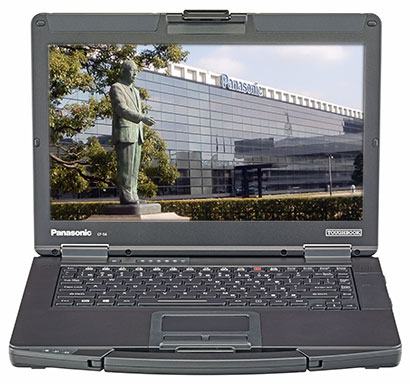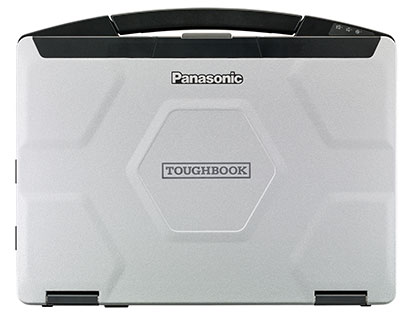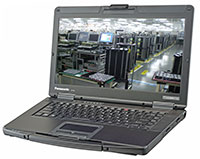On September 21, 2017, Panasonic introduced yet another upgrade to its Toughbook 54, a semi-rugged notebook that emphasizes light weight and a slim profile while providing very good performance with 6th and 7th generation Intel Core i5 and i7 processors as well as very good battery life (up to 20 hours with two batteries). The upgraded Toughbook 54 is designed to a highly portable tool for mobile professionals who need durability beyond what a standard consumer laptop can offer.

The Toughbook 54 is the successor to a whole series of prior semi-rugged Toughbooks — starting with the venerable Toughbook 51, then the 52 and 53 — all meant to provide lighter and more affordable alternatives to Panasonic's big and heavy fully rugged models while still offering robust construction and durability. Over the years, the Toughbook 5x Series has gone this way and that, responding to consumer demand for ultra-high resolution and other display options, early conversion to wide-format displays, focus on high performance, etc.
With the two most recent generrations of the Toughbook 54, Panasonic placed emphasis on reducing weight and giving its semi-rugged a sleek and slender profile. That's because it may be okay for rugged industrial gear to be on the bulky side, but smartphone and tablet toting mobile professionals want it thin and light these days. So the basic "Lite" 14-inch Toughbook 54 now weighs just 4.2 pounds, down 25% compared to the starting weight of the older Toughbook 53. And yet, it clearly remains a Toughbook, magnesium alloy construction with integrated carry handle and all.

What's the biggest change in this latest release? That would be the addition of two 7th generation "Kaby Lake" Intel Core processors (the two 6th generation "Skylake" Core processors from the prior generation of the Toughbook 54 remain available). Kaby Lake is, in essence, a tweaked version of Skylake that's also running at higher clock speeds. An important differentiation is that the Kaby Lake processor options are only available with Microsoft Windows 10. The two Skylake CPU options also come with Windows 10, but they still have a Windows 7 "downgrade option."
As far as performance goes, it's considerable for all of the available processors. We'd estimate a perhaps 10-15% performance increase for Kaby Lake options over the equivalent Skylake option. Another difference is the type of discrete graphics module available for "Performance" versions of the latest Toughbook 54. Skylake models get the AMD FirePro M5100, Kaby Lake versions the considerably faster and much newer AMD Radeon Pro WX 4150.
Available batteries remain at 34.8 (Lite) and 46.6 watt-hours (other versions), and an optional secondary battery packs 32.8 watt hours. That's good for a minimum of 7 hours with one battery and a maximum of 20 hours with two batteries, depending on processor and version.
In order to meet the wide variety of customer requirements, Panasonic offers the Toughbook 54 in four different models — Lite, Prime, Gloved Multi Touch, and Performance. Here are the primary differences between the four models:
|
Toughbook 54 Model
|
Lite
|
Prime
|
Gloved
|
Performance
|
|
Std/Max RAM
|
4-16GB/8-32GB
|
4-16GB/8-32GB
|
4-16GB/8-32GB
|
8-16GB/16-32GB
|
|
Display resolution
|
1366 x 768
|
1366 x 768
|
1920 x 1080
|
1920 x 1080
|
|
Direct bonded IPS
|
No
|
No
|
Yes
|
Yes
|
|
Discrete Graphics
|
No
|
No
|
No
|
Yes
|
|
Touch
|
No
|
No
|
Yes
|
No
|
|
1,000 nit luminance
|
No
|
No
|
Yes
|
No
|
|
Weight
|
4.2 lbs.
|
4.4 lbs.
|
4.6 lbs.
|
4.6 lbs.
|
|
Std. storage
|
500GB HD
|
256GB SSD
|
256GB SSD
|
256GB SSD
|
|
Opt. 2nd drive
|
No
|
Yes
|
Yes
|
Yes
|
|
Battery
|
34.8 whr
|
46.6 whr
|
46.6 whr
|
46.6 whr
|
|
Battery life
|
7/9 hrs.
|
10/11 hrs.
|
10/11 hrs.
|
10/11 hrs.
|
|
Optional Core i7
|
yes
|
yes
|
yes
|
yes
|
|
True RS232 port
|
No
|
Yes
|
Yes
|
Yes
|
|
Dual fan
|
No
|
No
|
No
|
Yes
|
|
Opt. web camera
|
No
|
Yes
|
Yes
|
Yes
|
|
Height
|
1.2"
|
1.2"
|
1.2"
|
1.4"
|
In addition to the four different models, customers may also specify 256GB, 512GB, or 1TB solid state disks, or a 1TB hard drive. The unit's media bay can accommodate a DVD Super Multi Drive, a second battery, or a PC Card slot. And customers may opt for either dedicated u-blox GPS or a 4th USB port or a rugged Fischer USB connector ora 2nd RJ45 LAN port. Note that 6th and 7th generation processors go with different RAM (DDR3L vs DDR4), different WiFi (Intel 8260 vs 8265), and likely some other componentry.
Standard I/O remains generous, consisting of three USB 3.0 ports, HDMI, RJ45 LAN, docking, audio in/out, a true RS232 serial DB9 connector (except on the Lite version), and a SDXC Card slot of the UHS-II variety, meaning it has an Ultra High Speed (UHS) bus with a theoretical data transfer rate up to 156 MB/s.
Below you can see what the backside and the right of the laptop look like, with protective doors open:

On the wireless front, there is 802.11a/b/g/n/ac WiFi of the Intel Dual Band Wireless-AC 8260 (Skylake) or 8265 (Kaby Lake) variety, Bluetooth 4.1 and Intel Wireless Display capability. Optional gear includes integrated 4G LTE multi carrier mobile broadband with satellite GPS, dedicated u-blox NEO-M8N GPS, contactless SmartCard/NFC reader, and a high-gain antenna pass-through.
As a semi-rugged machine, the Panasonic 54 has a spill and dust-resistant case, keyboard, touchpad and screen. Panasonic claims the machine passes nine MIL-STD-810G tests (drop, shock, vibration, dust, altitude, high/low temperature, thermal shock, and humidity). Initial data sheets don't go into ruggedness specifics other than stating the machine can survive  3 foot drops. That is very respectable for such a light machine, and significantly better than your garden-variety consumer laptop.
3 foot drops. That is very respectable for such a light machine, and significantly better than your garden-variety consumer laptop.
As for pricing, a base Toughbook 54 now starts at US$1,599 (up from US$1,499 for the prior gen), with higher-end and specially equipped models going for considerably more. That is reasonable, albeit more than the starting price of the Toughbook's primary competition, the Getac S410. As is, the Toughbook 54 remains a competent and remarkably light semi-rugged notebook. -- Conrad H. Blickenstorfer, September 2017



